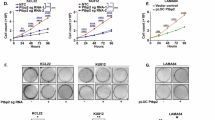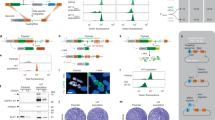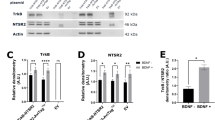Abstract
NTKL is an evolutionarily conserved kinase-like protein. The cell-cycle-dependent centrosomal localization of NTKL suggested that it was involved in centrosome-related cellular function. The mouse NTKL protein is highly homologous with human NTKL. A novel mouse protein was identified as an NTKL-binding protein (NTKL-BP1) by yeast two-hybrid screening, and the full-length cDNA was amplified based on the result of a sequence data analysis cloning strategy. The full-length cDNA sequence of the NTKL-BP1 gene consists of 2,537 bp, which encode 368 amino acids. A database search revealed that homologues of NTKL-BP1 exist in different organisms, including Arabidopsis thaliana, Drosophila melanogaster, Plasmodium falciparum, Geobacter metallireducens, Anopheles gambiae and human. It suggests that NTKL-BP1 is an evolutionarily conserved protein. The expression of NTKL-BP1 was observed in multiple normal mouse tissues. The interaction of the two proteins was confirmed by co-immunoprecipitation. Moreover, immunofluorescent staining indicated that NTKL and NTKL-BP1 were all localized in the cytoplasm.
Similar content being viewed by others
Log in or create a free account to read this content
Gain free access to this article, as well as selected content from this journal and more on nature.com
or
References
Allan V (1994) Organelle movement. Dynactin: portrait of a dynein regulator. Curr Biol 4:1000–1002
Boylan K, Serr M, Hays T (2000) A molecular genetic analysis of the interaction between the cytoplasmic dynein intermediate chain and the Glued (dynactin) complex. Mol Biol Cell 11:3791–3803
Compton DA (1998) Focusing on spindle poles J Cell Sci 111:1377–1481
Deng CX (2002) Roles of BRCA1 in centrosome duplication. Oncogene 21:6222–6227
Deng CX, Brodie SG (2000) Roles of BRCA1 and its interacting proteins. Bioessays 22:728–737
Derbyshire DJ, Basu BP, Date T, Iwabuchi K, Doherty AJ (2002) Purification, crystallization and preliminary X-ray analysis of the BRCT domains of human 53BP1 bound to the p53 tumour suppressor. Acta Crystallogr D Biol Crystallogr 58:1826–1829
Fanni G (2002) Centrosomal TACCtics. Bioessays 24:915–925
Frey RS, Li J, Singletary KW (2001) Effects of genistein on cell proliferation and cell cycle arrest in nonneoplastic human mammary epithelial cells: involvement of Cdc2, p21 (waf/cip1), p27 (kip1), and Cdc25C expression. Biochem Pharmacol 61:979–989
Fry DW, Bedford DC, Harvey PH, Fritsch A, Keller PR, Wu Z, Dobrusin E, Leopold WR, Fattaey A, Garrett MD (2001) Cell cycle and biochemical effects of PD 0183812, A potent inhibitor of the cyclin D-dependent kinases CDK4 and CDK6. J Biol Chem 276:16617–16623
Huang CF, Chang CB, Huang C, and Ferrell JE (1999) M phase phosphorylation of cytoplasmic dynein intermediate chain and p150Glued. J Biol Chem 274:14262–14269
Joo WS, Jeffrey PD, Cantor SB, Finnin MS, Livingston DM, Pavletich NP (2002) Structure of the 53BP1 BRCT region bound to p53 and its comparison to the Brca1 BRCT structure. Genes Dev 16:583–593
Kahana AJ, Schlenstedt G, Evanchuk DM, Geiser JR, Hoyt MA, Silver PA (1998) The yeast dynactin complex is involved in partitioning the mitotic spindle between mother and daughter cells during anaphase B. Mol Biol Cell 9:1741–1756
Kato M, Yano K, Morotomi-Yano K, Saito H, Miki Y (2002) Identification and characterization of the human protein kinase-like gene NTKL: mitosis-specific centrosomal localization of an alternatively spliced isoform. Genomics 79:760–767
Kukri S, Holzbaur ELF (1999) Cytoplasmic dynein and dynactin in cell division and intracellular transport. Curr Opin Cell Biol 11:45–53
Liu SCH, Lane WS, Lienhard GE (2000) Cloning and preliminary characterization of a 105-kDa protein with an N-terminal kinase-like domain. Biochim Biophys Acta 1517:148–152
Mayor T, Meraldi P, Stierhof YD, Nigg EA, Fry AM (1999) Protein kinases in control of the centrosome cycle. FEBS Lett 452:92-95
Rieder CL, Faruki S, Khodjakov A (2001) The centrosome in vertebrates: more than a microtubule-organizing center. Trend Cell Biol.11:413–419
Sommi P, Savio M, Stivala LA, Scotti C, Mignosi P, Prosperi E, Vannini V, Solcia E (2002) Helicobacter pylori releases a factor(s) inhibiting cell cycle progression of human gastric cell lines by affecting cyclin E/cdk2 kinase activity and Rb protein phosphorylation through enhanced p27 (KIP1) protein expression. Exp Cell Re 281: 128–139
Sluder G, Hinchcliffe EH (1999) Control of centrosome reproduction: the right number at the right time. Biol Cell 91: 413–427
Stearns T (2001). Centrosome duplication: a centriolar pas de deux. Cell 105:417–420
Vaughan PS, Miura P, Henderson M, Byren B, and Vaughan KT (2002) A role for regulated binding of p150Glued to microtubule plus ends in organelle transport. J Cell Biol 158: 305–319
Villerbu N, Gaben AM, Redeuilh G, Mester J (2002) Cellular effects of purvalanol A: a specific inhibitor of cyclin-dependent kinase activities. Int J Cancer 97:761–769
Zeng C (2000) NuMA: a nuclear protein involved in mitotic centrosome function. Microsc Res Tech 49:467–477
Zimmerman W, Doxsey SJ (2000) Construction of centrosomes and spindle poles by molecular motor-driven assembly of protein particles. Traffic 1:927–934
Zimmerman W, Sparks CA, Doxsey SJ (1999) Amorphous no longer: the centrosome comes into focus. Curr Opin Cell Biol 11:122–128
Acknowledgements
This work was supported by Chinese National Key Grant of Basic Research (2001CB510203) and National 863 Program Grant (2002AA 227011).
Author information
Authors and Affiliations
Corresponding author
Rights and permissions
About this article
Cite this article
Di, Y., Li, J., Fang, J. et al. Cloning and characterization of a novel gene which encodes a protein interacting with the mitosis-associated kinase-like protein NTKL. J Hum Genet 48, 315–321 (2003). https://doi.org/10.1007/s10038-003-0031-5
Received:
Accepted:
Published:
Issue date:
DOI: https://doi.org/10.1007/s10038-003-0031-5
Keywords
This article is cited by
-
GORAB scaffolds COPI at the trans-Golgi for efficient enzyme recycling and correct protein glycosylation
Nature Communications (2019)
-
Gorab is a Golgi protein required for structure and duplication of Drosophila centrioles
Nature Genetics (2018)
-
SCY1-Like 1-Binding Protein 1 (SCYL1BP1) Suppressed Sciatic Nerve Regeneration by Enhancing the RhoA Pathway
Molecular Neurobiology (2016)
-
GORAB Missense Mutations Disrupt RAB6 and ARF5 Binding and Golgi Targeting
Journal of Investigative Dermatology (2015)
-
SCY1-like 1 binding protein 1 (SCYL1-bp1) interacts with p53-induced RING H2 protein (Pirh2) after traumatic brain injury in rats
Journal of Molecular Histology (2013)



